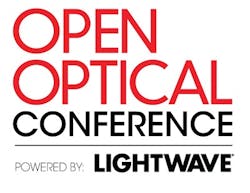Open optical line system pros and cons at the Open Optical Conference
Lightwave's inaugural Open Optical Conference, held November 2 in Dallas, TX, illustrated the diversity of network operator requirements for open optical communications systems and an equally varied response set from vendors. Open optical line systems, likely the first area where open optical systems will make their mark in the evolution toward automated fiber network operation, dominated conversation at the event – and left attendees wondering if a common approach for the majority of requirements is possible in the near term.
A general agreement on the basic building blocks for open optical line systems emerged. The elements include WDM and/or ROADMs (the latter necessary for mesh network architectures), transponders, and amplifiers. Of course, the capabilities of these elements can vary widely; the eventual use of superchannels and Nyquist subcarriers to transmit coherent wavelengths of 400 Gbps and above will require that open line systems possess flex-grid capabilities, pointed out Jay Gill, principal product marketing manager at Infinera. Few open line systems currently possess such features currently, he added.
Nevertheless, open optical line systems are available for operators interested in working with them. They range from white box offerings such as those from Lumentum (cited several times during the day) and the Telecom Infra Project's Voyager switch/transport hybrid platform to more proprietary, yet disaggregated ROADM offerings such as those from Ciena, Fujitsu Network Communications, and Nokia adapted for use within the OpenROADM multisource agreement (MSA; see "AT&T field tests Open ROADM technology"). Regardless of origin, these systems share open interfaces and that enable interworking with each other and with software-defined networking (SDN) controllers. The goal in many instances is to separate control from the hardware; Andrew Leong, network manager, optical engineering at Facebook, said his ideal is to see direct control of network elements from an SDN controller without having to work through an optical network management system as an intermediary.
However, despite the consensus on the points above, operators don't agree on how they plan to implement such capabilities. A difference of opinion between internet content providers and mainstream service providers would be expected due to their differing network histories and requirements. Yet even within these two demographics, conflicting opinions emerged.
Such a divergence crystalized in the presentations from AT&T and Verizon. Martin Birk, lead member of technical staff at AT&T, described the carrier's embrace of open optical systems in his talk. The company has taken the lead within the OpenROADM MSA and has openly discussed an interest in white box optical systems (see "AT&T: Operators should take more responsibility for their network technology"). Conversely, Glenn Wellbrock, director of optical transport network architecture, design, and planning at Verizon, delivered a list of questions regarding open optical line systems for which he has yet to hear satisfactory answers. The list includes:
- Who becomes the system integrator? (Wellbrock said he has no interest in assuming this role.)
- How much will the integrator charge?
- How can open systems be cheaper when all the same elements are needed?
- How can open systems be faster to market when third-party testing is required?
- How would Verizon ensure interoperability and backward compatibility of all vendors?
- What new functionality is being introduced or enabled via open systems?
Several vendor speakers acknowledged that they'll have to support a spectrum of approaches to open optical systems deployment among their customers. During the closing panel, the vendor participants were asked whether they thought their companies would be able to meet the divergent needs of both mainstream service providers and data center operators with a single product portfolio. Robert Keys, vice president of engineering at Juniper Networks (which had announced its strategy to support open optical line systems use the day before the event), expressed confidence that his company could. Gill, however, indicated that some divergence of offerings might still be necessary.
It's clear that, despite the steps forward speakers at the conference described, the evolution towards open optical systems remains in an early stage.
For related articles, visit the Network Design Topic Center.
For more information on high-speed transmission systems and suppliers, visit the Lightwave Buyer's Guide.
About the Author
Stephen Hardy
Editorial Director and Associate Publisher
Stephen Hardy has covered fiber optics for more than 15 years, and communications and technology for more than 30 years. He is responsible for establishing and executing Lightwave's editorial strategy across its digital magazine, website, newsletters, research and other information products. He has won multiple awards for his writing.
Contact Stephen to discuss:
- Contributing editorial material to the Web site or digital magazine
- The direction of a digital magazine issue, staff-written article, or event
- Lightwave editorial attendance at industry events
- Arranging a visit to Lightwave's offices
- Coverage of announcements
- General questions of an editorial nature

